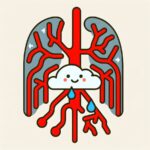Ventricular Septal Defect (VSD) is a heart condition that can seem daunting to new parents navigating their baby’s health. Often detected in infancy, VSD involves an opening in the septum separating the heart’s lower chambers. This guide aims to demystify VSD, providing valuable insights into its causes, symptoms, treatment, and what parents can do to ensure their child thrives despite this condition.
What is Ventricular Septal Defect?
Ventricular Septal Defect is among the most common congenital heart defects, occurring in approximately 1 in 500 births. The defect consists of one or more openings in the ventricular septum, leading to the mixing of oxygen-rich and oxygen-poor blood. This can put extra strain on the heart and lungs, leading to a range of symptoms.
The size and location of the VSD play a crucial role in determining the impact on the child’s health. Small defects may close on their own and often don’t require treatment, while larger defects could necessitate medical intervention to prevent complications.
Identifying Symptoms of Ventricular Septal Defect
Recognizing the symptoms of VSD is key to early diagnosis and management. Infants with a significant VSD might exhibit signs of heart failure such as rapid breathing, difficulty feeding, poor weight gain, and fatigue. However, smaller VSDs might present minimal to no symptoms, often being discovered during routine check-ups.
It’s essential for parents to monitor their baby for any unusual signs and consult with a pediatrician if concerns arise. Early intervention can make a significant difference in managing the condition and ensuring a healthy development for your child.
Treatment Options for Ventricular Septal Defect
The treatment for VSD depends on the defect’s size, location, and the symptoms it causes. Smaller VSDs might not require any treatment and may close spontaneously as the child grows. Moderate to large VSDs, however, may require medication to manage symptoms or surgery to close the defect.
Surgical options include traditional open-heart surgery or less invasive catheter procedures, depending on the specific case. It’s vital to work closely with a pediatric cardiologist to determine the best course of action for your child.
For further information on congenital heart diseases and how they can affect your baby’s development, consider reading about congenital heart disease.
Living with Ventricular Septal Defect: Tips for Parents
Raising a child with VSD can be challenging, but with the right support and information, parents can ensure their child leads a healthy and fulfilling life. Ensuring regular follow-ups with healthcare providers, sticking to the treatment plan, and being vigilant about symptoms are crucial steps.
Additionally, joining support groups and connecting with other families facing similar challenges can provide valuable emotional support and practical advice. Remember, many children with VSD grow up to lead normal, active lives.
Understanding related conditions can also be helpful. Learn about the signs and management of heart murmurs, a condition often associated with VSD, to better care for your child.
Conclusion
Ventricular Septal Defect, while a serious heart condition, can be managed effectively with the right medical care and support. Being informed about VSD, recognizing the symptoms early, and adhering to the treatment plan are key to ensuring your child’s health and well-being. With advancements in medical science, children with VSD have a promising outlook for a healthy future.
For more resources on infant health and how to navigate various conditions, visit Baby Whys and Hows. Our library offers comprehensive insights into a wide range of topics, ensuring you’re well-equipped to support your baby’s development every step of the way.













